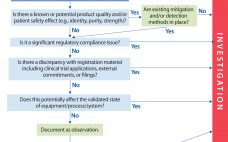Triton X-100 detergent makes an interesting case study in bioprocess sustainability strategy. Also known as octylphenol ethoxylate (OPE), this nonionic surfactant has many uses in biopharmaceutical research and development. Among other laboratory applications, it is used to lyse cells and DNA in research, to solubilize membrane proteins and decellularize animal-derived tissues, to reduce the surface tension of aqueous solutions during immunostaining, and to remove sodium dodecyl sulfate (SDS) from polyacrylamide gel electrophoresis (PAGE) gels for analysis. It also serves as…
Risk Management
Viral Risk Mitigation: A Global Regulatory Perspective
The production of biologics will always have the risk of viral contamination. Manufacturers have developed a multitiered approach — tailored to individual processes — to prevent adventitious viruses from entering production processes, detect contamination in raw materials and process intermediates, and remove viruses in downstream purification. This article provides an overview of the global regulatory framework to ensure the viral safety of biologics. Past Contamination Events Past contamination events have resulted in corrective and preventative actions to reduce the risk…
Proposing a Systematic QbD Approach Toward Validated Guidelines for CMO RFI and RFP Processes: Biopharmaceutical Vendor Evaluation and Selection Minimum Standards (BioVesel)
Three major concerns predominate biotechnology executive management in organizations of all sizes and above all other risks: finance (or its absence at critical moments), technological performance, and failures in coordination. Some business functions, such as human resources (HR), are effectively siloed horizontally and therein are more likely to be susceptible to only one of those risks (1). Few functions are subject to this trinity of risks simultaneously; all functions may be exposed to failures in internal coordination, and a smaller…
Accelerated Development, Manufacturing and Monitoring of Viral Vectors
The goals of process intensification are to enhance production while shortening timelines, lessening contamination and environmental risks to products and operators, and reducing operating footprints. Previous publications from Sartorius Stedim Biotech (SSB) have highlighted key elements of such activities. In this report, the authors extend the scope of this discussion to tools and technologies that enable intensification of viral vector manufacturing processes. The first article summarizes presentations from a 2018 seminar for viral vaccine manufacturers. Three guest presentations highlighted the…
Using New Technologies to Compress Timelines, Increase Capacity, and Reduce Costs: Speed — Why, When, and How
Moderator Tom Ransohoff, with Jorg Thommes, Chris Love, Rajesh Beri, and Geoffrey Hodge For biopharmaceuticals to mature as a process industry, companies need to embrace the ability to adopt new technologies and bring new operational approaches to their biomanufacturing facilities. In this roundtable about adopting and implementing new technologies in the biologics industry, moderator Tom Ransohoff stressed the importance of understanding drivers for adopting new technologies and of developing enabling processes that factor in associated risks and challenges. He offered…
Host-Cell Protein Risk Management and Control During Bioprocess Development: A Consolidated Biotech Industry Review, Part 2
Even with increased understanding of host cell proteins (HCPs) and their potential risks, no practical approach has been made available for HCP risk management during bioprocess development. A BioPhorum Development Group (BPDG) team has identified common HCP-related risk factors and built a template for semiquantitative risk assessment during process development based on publicly available information. To this end, the BPDG HCP working team’s assay and knowledge-sharing experts have established a common HCP risk assessment tool and mitigation strategy to guide…
Host-Cell Protein Risk Management and Control During Bioprocess Development: A Consolidated Biotech Industry Review, Part 1
Host-cell proteins (HCPs) constitute a significant class of process-related impurities during biologics manufacturing. Due to their potential impact on product quality and efficacy as well as patient safety, the total amount of residual HCP in a biological drug substance generally is considered a critical quality attribute (CQA) that usually needs to be tested for during batch release (1, 2). It is both an “industrywide” common understanding and a regulatory requirement to remove HCPs from biologics to acceptably low levels that…
Back to Basics for Biotech: Driving a Culture of Quality and Compliance with Practical Communication Techniques
The robust regulatory environment surrounding biotechnology and bioprocessing demands a comprehensive current good manufacturing practice (CGMP) culture of quality, compliance, and absolute adherence to policy. Employees need to be engaged in their work, with a laser focus on meeting stringent specifications and operating under tight controls. A misstep in quality or compliance can lead to hefty fines, legal concerns, regulatory retaliation, and reputational damage. Communication and stakeholder engagement are critical to aligning organizations and driving the right culture in highly…
Beyond Compliance: Serialization Has More to Offer
As the global pharmaceutical industry implements serialization (track and trace from manufacturing to dispensing) to meet governmental regulatory requirements, other opportunities arise for drug companies. The main driver here is to improve the integrity of the overall drug supply chain, but other meaningful business benefits can come from serialization. Generally accomplished through automated, electronic means, it involves such practices as recording, authenticating, maintaining, and sharing accurate records of products. Outside-the-Box Benefits In addition to tightening up the supply chain and…
Transforming Deviation Management
All biopharmaceutical companies espouse a belief in scientific, risk-based approaches. However, with respect to deviation management systems (DMSs), the industry is falling short of that promise. By and large, companies still use a small-molecule pharmaceutical compliance model that dates back to the 1980s, based on the strategy that all deviations are created equal and require 30-day closure. Most bioprocessors still hold to a default 30-day rule, even though there is no specific regulatory requirement for that time frame. Major or…









